UK Company Gender Pay Gap Analysis: Sainsbury's and Equality Act 2010
VerifiedAdded on 2023/01/04
|9
|2188
|25
Report
AI Summary
This report provides an in-depth analysis of the gender pay gap within Sainsbury's, a prominent UK-based company, highlighting the disparities in compensation between male and female employees. It examines the nature of the issue, emphasizing its negative impact on economic production and the potential for increased welfare dependency among women. The report delves into the Equality Act 2010, outlining its provisions against discrimination and its role in addressing the pay gap. It discusses the Act's relevance to Sainsbury's, including the legal framework for addressing unequal treatment and the importance of managerial support. The report offers recommendations, emphasizing the use of the Equality Act 2010 to assess the root causes of the pay gap and proposes a timeline, prioritizing key tasks and considering associated costs. The conclusion summarizes the findings, reiterating the significance of the gender pay gap and the effectiveness of the Equality Act 2010 in mitigating such issues within the company's operations.

Project
Paraphrase This Document
Need a fresh take? Get an instant paraphrase of this document with our AI Paraphraser
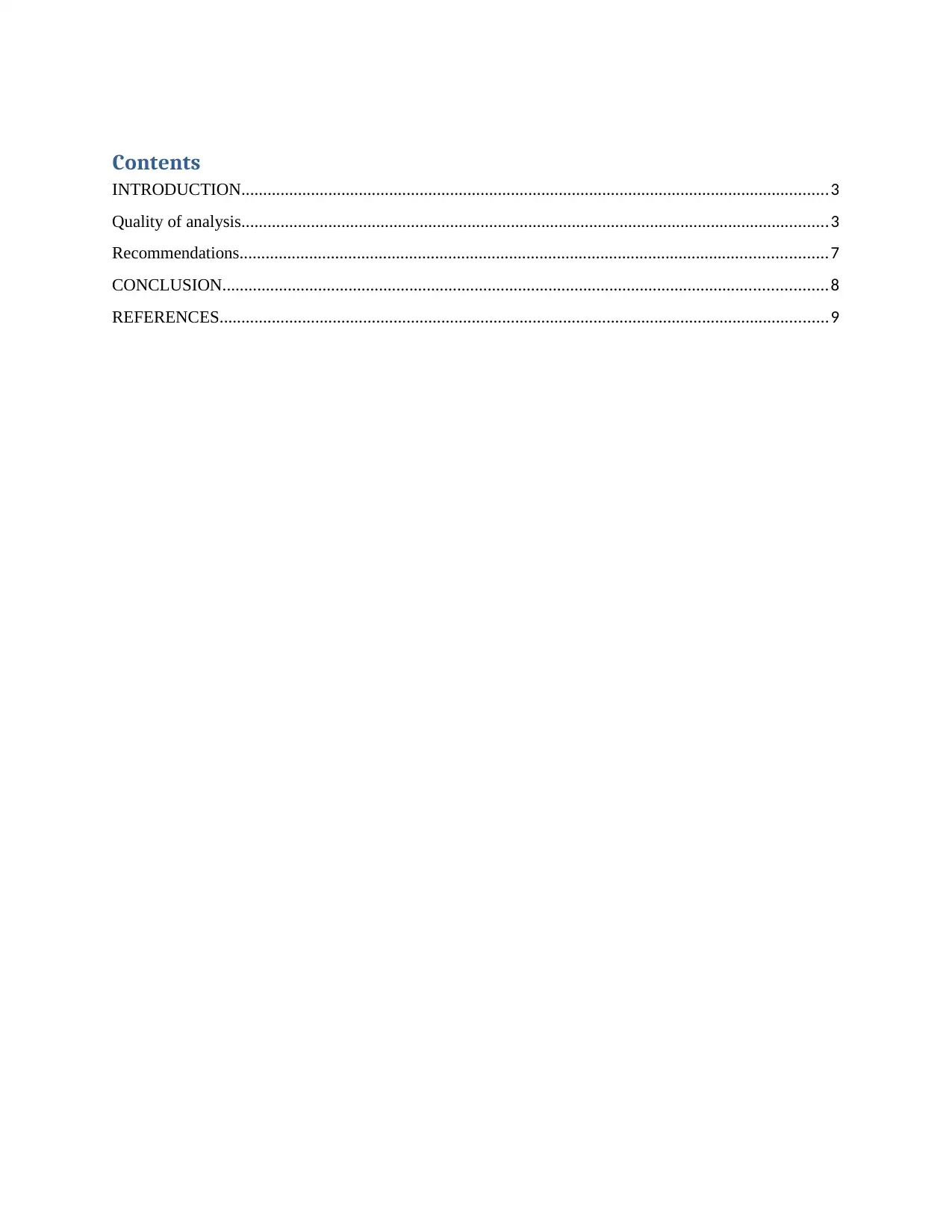
Contents
INTRODUCTION.......................................................................................................................................3
Quality of analysis.......................................................................................................................................3
Recommendations.......................................................................................................................................7
CONCLUSION...........................................................................................................................................8
REFERENCES............................................................................................................................................9
INTRODUCTION.......................................................................................................................................3
Quality of analysis.......................................................................................................................................3
Recommendations.......................................................................................................................................7
CONCLUSION...........................................................................................................................................8
REFERENCES............................................................................................................................................9
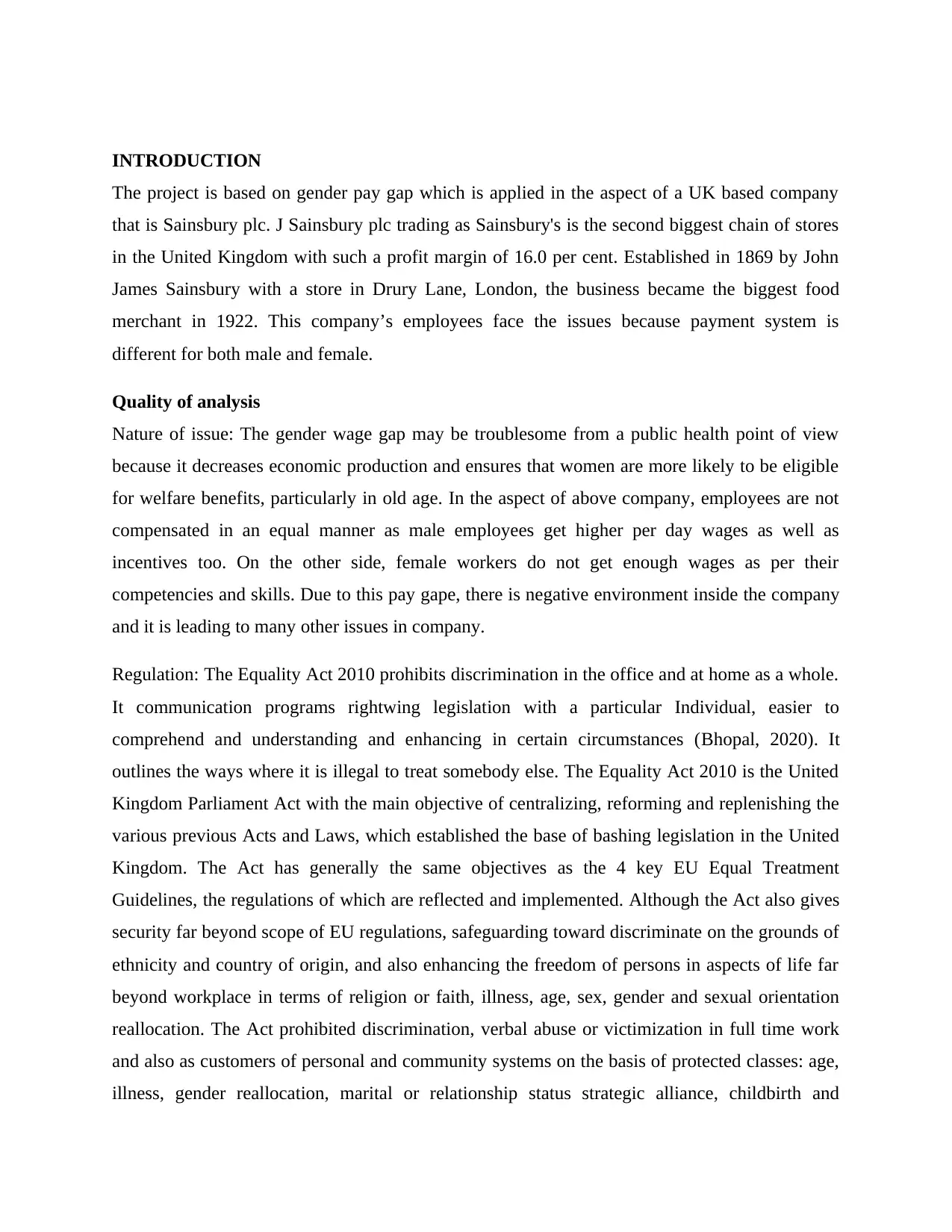
INTRODUCTION
The project is based on gender pay gap which is applied in the aspect of a UK based company
that is Sainsbury plc. J Sainsbury plc trading as Sainsbury's is the second biggest chain of stores
in the United Kingdom with such a profit margin of 16.0 per cent. Established in 1869 by John
James Sainsbury with a store in Drury Lane, London, the business became the biggest food
merchant in 1922. This company’s employees face the issues because payment system is
different for both male and female.
Quality of analysis
Nature of issue: The gender wage gap may be troublesome from a public health point of view
because it decreases economic production and ensures that women are more likely to be eligible
for welfare benefits, particularly in old age. In the aspect of above company, employees are not
compensated in an equal manner as male employees get higher per day wages as well as
incentives too. On the other side, female workers do not get enough wages as per their
competencies and skills. Due to this pay gape, there is negative environment inside the company
and it is leading to many other issues in company.
Regulation: The Equality Act 2010 prohibits discrimination in the office and at home as a whole.
It communication programs rightwing legislation with a particular Individual, easier to
comprehend and understanding and enhancing in certain circumstances (Bhopal, 2020). It
outlines the ways where it is illegal to treat somebody else. The Equality Act 2010 is the United
Kingdom Parliament Act with the main objective of centralizing, reforming and replenishing the
various previous Acts and Laws, which established the base of bashing legislation in the United
Kingdom. The Act has generally the same objectives as the 4 key EU Equal Treatment
Guidelines, the regulations of which are reflected and implemented. Although the Act also gives
security far beyond scope of EU regulations, safeguarding toward discriminate on the grounds of
ethnicity and country of origin, and also enhancing the freedom of persons in aspects of life far
beyond workplace in terms of religion or faith, illness, age, sex, gender and sexual orientation
reallocation. The Act prohibited discrimination, verbal abuse or victimization in full time work
and also as customers of personal and community systems on the basis of protected classes: age,
illness, gender reallocation, marital or relationship status strategic alliance, childbirth and
The project is based on gender pay gap which is applied in the aspect of a UK based company
that is Sainsbury plc. J Sainsbury plc trading as Sainsbury's is the second biggest chain of stores
in the United Kingdom with such a profit margin of 16.0 per cent. Established in 1869 by John
James Sainsbury with a store in Drury Lane, London, the business became the biggest food
merchant in 1922. This company’s employees face the issues because payment system is
different for both male and female.
Quality of analysis
Nature of issue: The gender wage gap may be troublesome from a public health point of view
because it decreases economic production and ensures that women are more likely to be eligible
for welfare benefits, particularly in old age. In the aspect of above company, employees are not
compensated in an equal manner as male employees get higher per day wages as well as
incentives too. On the other side, female workers do not get enough wages as per their
competencies and skills. Due to this pay gape, there is negative environment inside the company
and it is leading to many other issues in company.
Regulation: The Equality Act 2010 prohibits discrimination in the office and at home as a whole.
It communication programs rightwing legislation with a particular Individual, easier to
comprehend and understanding and enhancing in certain circumstances (Bhopal, 2020). It
outlines the ways where it is illegal to treat somebody else. The Equality Act 2010 is the United
Kingdom Parliament Act with the main objective of centralizing, reforming and replenishing the
various previous Acts and Laws, which established the base of bashing legislation in the United
Kingdom. The Act has generally the same objectives as the 4 key EU Equal Treatment
Guidelines, the regulations of which are reflected and implemented. Although the Act also gives
security far beyond scope of EU regulations, safeguarding toward discriminate on the grounds of
ethnicity and country of origin, and also enhancing the freedom of persons in aspects of life far
beyond workplace in terms of religion or faith, illness, age, sex, gender and sexual orientation
reallocation. The Act prohibited discrimination, verbal abuse or victimization in full time work
and also as customers of personal and community systems on the basis of protected classes: age,
illness, gender reallocation, marital or relationship status strategic alliance, childbirth and
⊘ This is a preview!⊘
Do you want full access?
Subscribe today to unlock all pages.

Trusted by 1+ million students worldwide
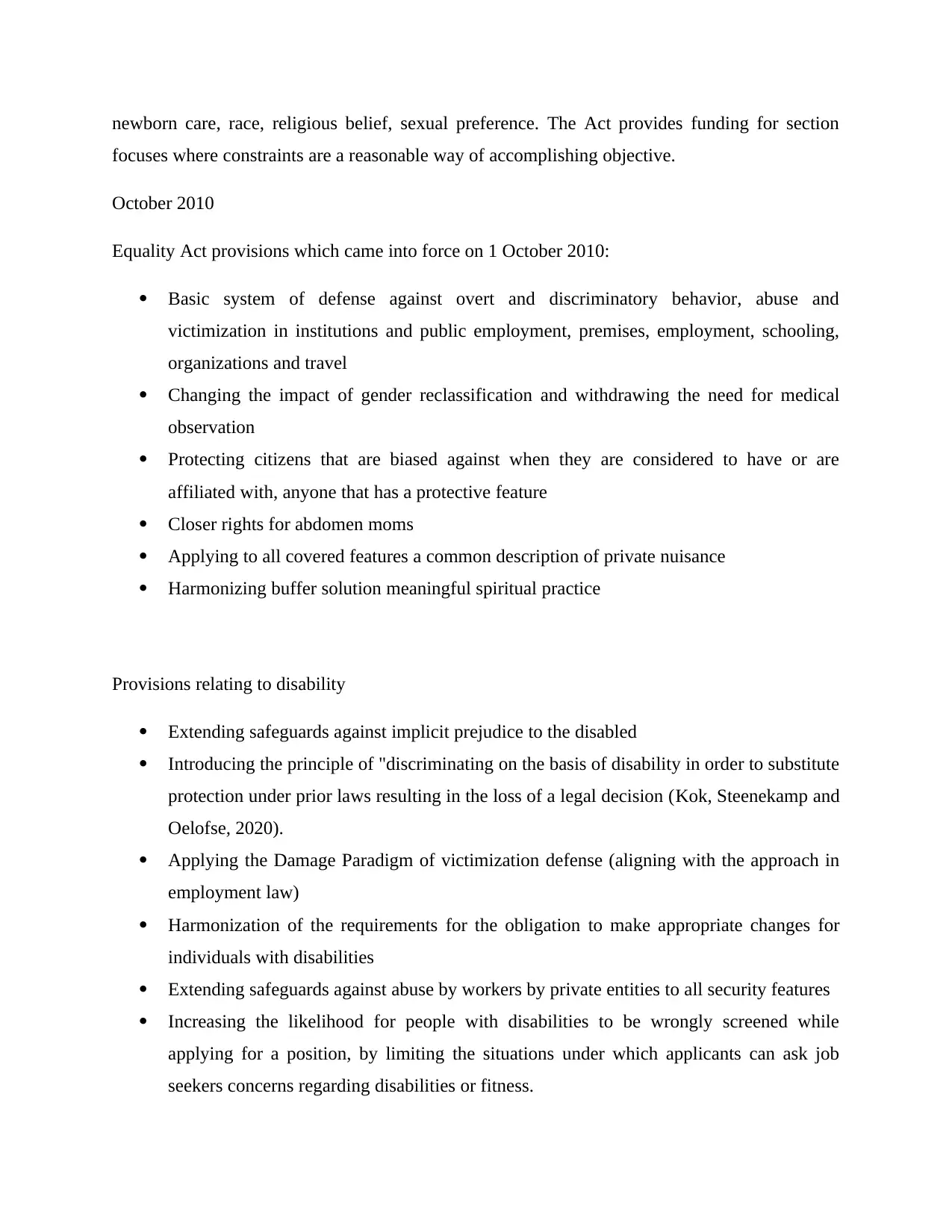
newborn care, race, religious belief, sexual preference. The Act provides funding for section
focuses where constraints are a reasonable way of accomplishing objective.
October 2010
Equality Act provisions which came into force on 1 October 2010:
Basic system of defense against overt and discriminatory behavior, abuse and
victimization in institutions and public employment, premises, employment, schooling,
organizations and travel
Changing the impact of gender reclassification and withdrawing the need for medical
observation
Protecting citizens that are biased against when they are considered to have or are
affiliated with, anyone that has a protective feature
Closer rights for abdomen moms
Applying to all covered features a common description of private nuisance
Harmonizing buffer solution meaningful spiritual practice
Provisions relating to disability
Extending safeguards against implicit prejudice to the disabled
Introducing the principle of "discriminating on the basis of disability in order to substitute
protection under prior laws resulting in the loss of a legal decision (Kok, Steenekamp and
Oelofse, 2020).
Applying the Damage Paradigm of victimization defense (aligning with the approach in
employment law)
Harmonization of the requirements for the obligation to make appropriate changes for
individuals with disabilities
Extending safeguards against abuse by workers by private entities to all security features
Increasing the likelihood for people with disabilities to be wrongly screened while
applying for a position, by limiting the situations under which applicants can ask job
seekers concerns regarding disabilities or fitness.
focuses where constraints are a reasonable way of accomplishing objective.
October 2010
Equality Act provisions which came into force on 1 October 2010:
Basic system of defense against overt and discriminatory behavior, abuse and
victimization in institutions and public employment, premises, employment, schooling,
organizations and travel
Changing the impact of gender reclassification and withdrawing the need for medical
observation
Protecting citizens that are biased against when they are considered to have or are
affiliated with, anyone that has a protective feature
Closer rights for abdomen moms
Applying to all covered features a common description of private nuisance
Harmonizing buffer solution meaningful spiritual practice
Provisions relating to disability
Extending safeguards against implicit prejudice to the disabled
Introducing the principle of "discriminating on the basis of disability in order to substitute
protection under prior laws resulting in the loss of a legal decision (Kok, Steenekamp and
Oelofse, 2020).
Applying the Damage Paradigm of victimization defense (aligning with the approach in
employment law)
Harmonization of the requirements for the obligation to make appropriate changes for
individuals with disabilities
Extending safeguards against abuse by workers by private entities to all security features
Increasing the likelihood for people with disabilities to be wrongly screened while
applying for a position, by limiting the situations under which applicants can ask job
seekers concerns regarding disabilities or fitness.
Paraphrase This Document
Need a fresh take? Get an instant paraphrase of this document with our AI Paraphraser
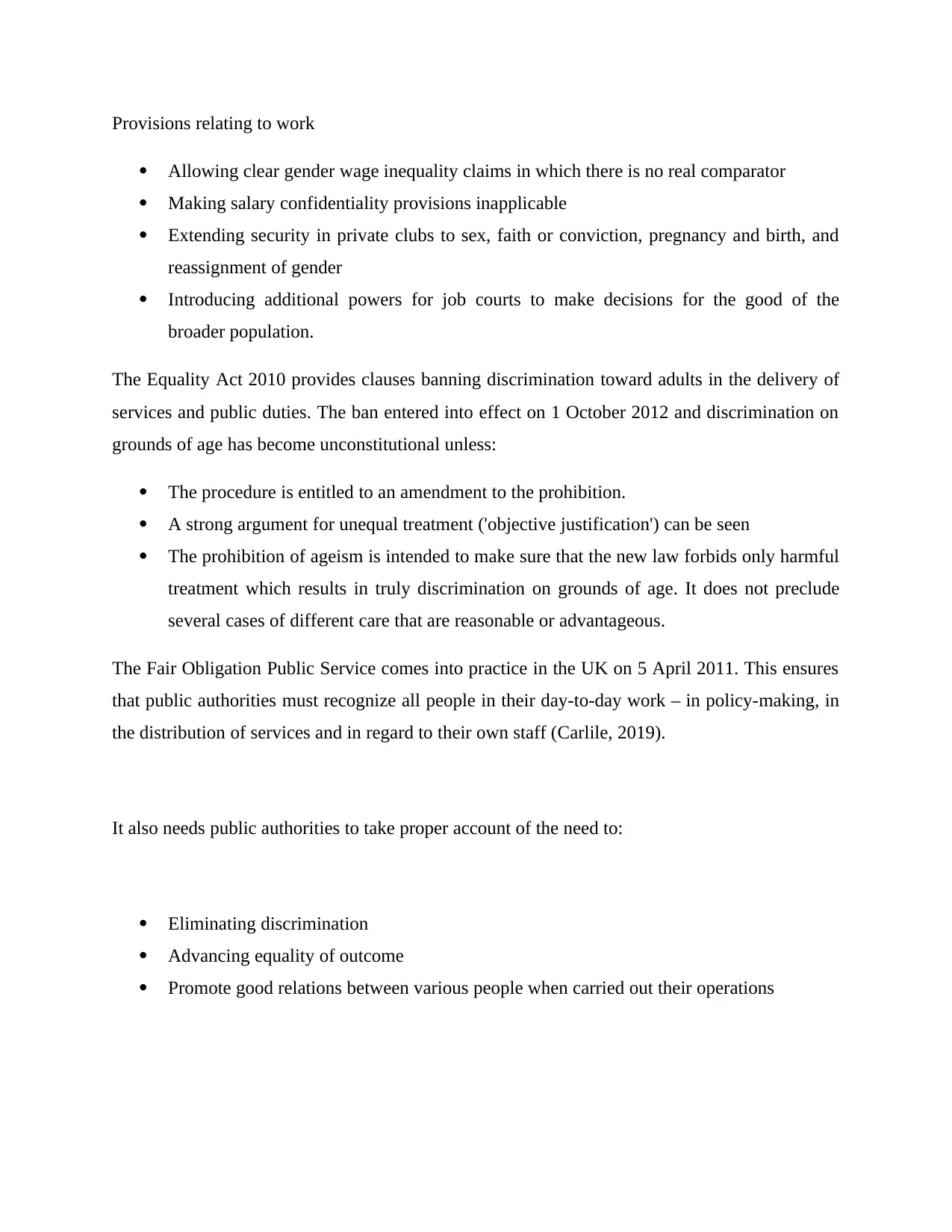
Provisions relating to work
Allowing clear gender wage inequality claims in which there is no real comparator
Making salary confidentiality provisions inapplicable
Extending security in private clubs to sex, faith or conviction, pregnancy and birth, and
reassignment of gender
Introducing additional powers for job courts to make decisions for the good of the
broader population.
The Equality Act 2010 provides clauses banning discrimination toward adults in the delivery of
services and public duties. The ban entered into effect on 1 October 2012 and discrimination on
grounds of age has become unconstitutional unless:
The procedure is entitled to an amendment to the prohibition.
A strong argument for unequal treatment ('objective justification') can be seen
The prohibition of ageism is intended to make sure that the new law forbids only harmful
treatment which results in truly discrimination on grounds of age. It does not preclude
several cases of different care that are reasonable or advantageous.
The Fair Obligation Public Service comes into practice in the UK on 5 April 2011. This ensures
that public authorities must recognize all people in their day-to-day work – in policy-making, in
the distribution of services and in regard to their own staff (Carlile, 2019).
It also needs public authorities to take proper account of the need to:
Eliminating discrimination
Advancing equality of outcome
Promote good relations between various people when carried out their operations
Allowing clear gender wage inequality claims in which there is no real comparator
Making salary confidentiality provisions inapplicable
Extending security in private clubs to sex, faith or conviction, pregnancy and birth, and
reassignment of gender
Introducing additional powers for job courts to make decisions for the good of the
broader population.
The Equality Act 2010 provides clauses banning discrimination toward adults in the delivery of
services and public duties. The ban entered into effect on 1 October 2012 and discrimination on
grounds of age has become unconstitutional unless:
The procedure is entitled to an amendment to the prohibition.
A strong argument for unequal treatment ('objective justification') can be seen
The prohibition of ageism is intended to make sure that the new law forbids only harmful
treatment which results in truly discrimination on grounds of age. It does not preclude
several cases of different care that are reasonable or advantageous.
The Fair Obligation Public Service comes into practice in the UK on 5 April 2011. This ensures
that public authorities must recognize all people in their day-to-day work – in policy-making, in
the distribution of services and in regard to their own staff (Carlile, 2019).
It also needs public authorities to take proper account of the need to:
Eliminating discrimination
Advancing equality of outcome
Promote good relations between various people when carried out their operations
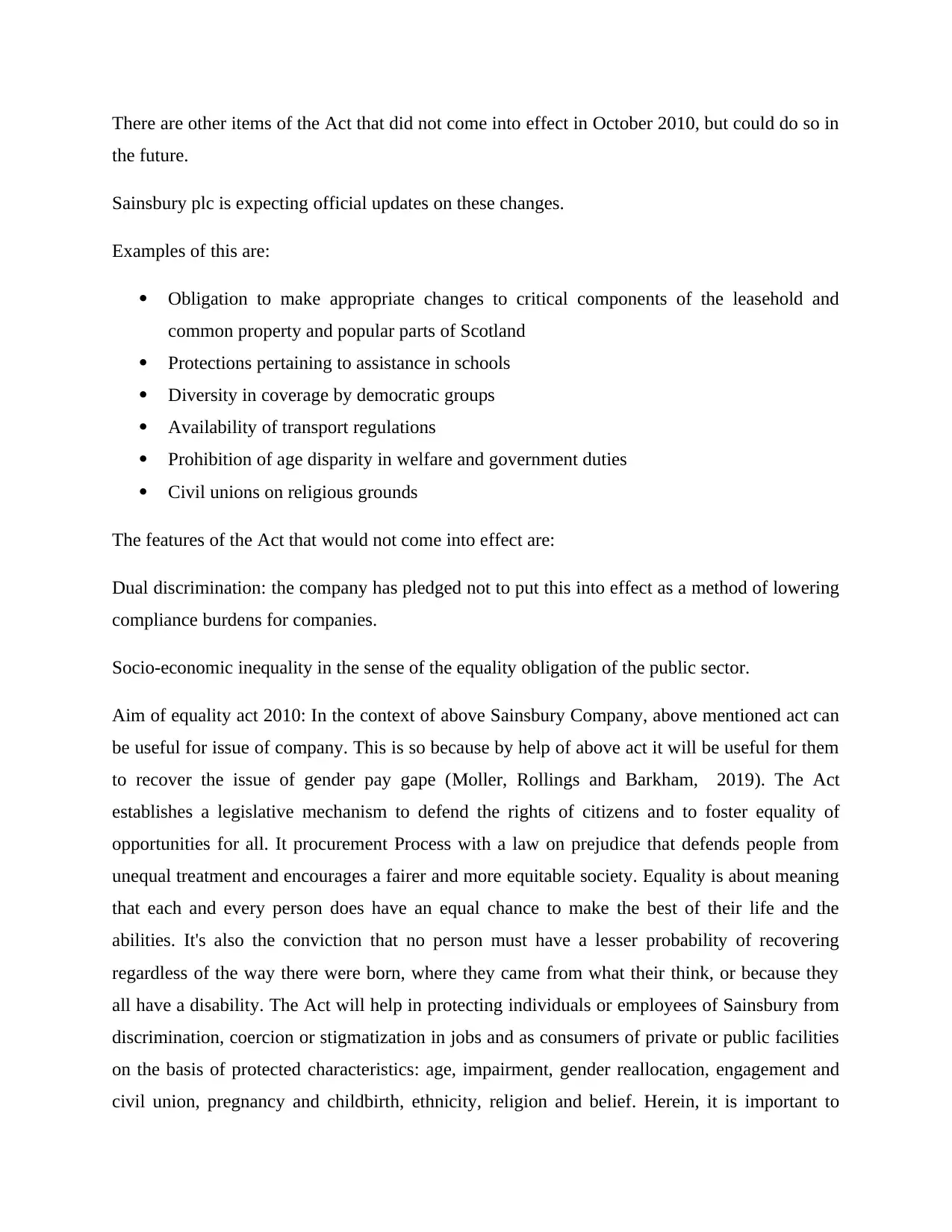
There are other items of the Act that did not come into effect in October 2010, but could do so in
the future.
Sainsbury plc is expecting official updates on these changes.
Examples of this are:
Obligation to make appropriate changes to critical components of the leasehold and
common property and popular parts of Scotland
Protections pertaining to assistance in schools
Diversity in coverage by democratic groups
Availability of transport regulations
Prohibition of age disparity in welfare and government duties
Civil unions on religious grounds
The features of the Act that would not come into effect are:
Dual discrimination: the company has pledged not to put this into effect as a method of lowering
compliance burdens for companies.
Socio-economic inequality in the sense of the equality obligation of the public sector.
Aim of equality act 2010: In the context of above Sainsbury Company, above mentioned act can
be useful for issue of company. This is so because by help of above act it will be useful for them
to recover the issue of gender pay gape (Moller, Rollings and Barkham, 2019). The Act
establishes a legislative mechanism to defend the rights of citizens and to foster equality of
opportunities for all. It procurement Process with a law on prejudice that defends people from
unequal treatment and encourages a fairer and more equitable society. Equality is about meaning
that each and every person does have an equal chance to make the best of their life and the
abilities. It's also the conviction that no person must have a lesser probability of recovering
regardless of the way there were born, where they came from what their think, or because they
all have a disability. The Act will help in protecting individuals or employees of Sainsbury from
discrimination, coercion or stigmatization in jobs and as consumers of private or public facilities
on the basis of protected characteristics: age, impairment, gender reallocation, engagement and
civil union, pregnancy and childbirth, ethnicity, religion and belief. Herein, it is important to
the future.
Sainsbury plc is expecting official updates on these changes.
Examples of this are:
Obligation to make appropriate changes to critical components of the leasehold and
common property and popular parts of Scotland
Protections pertaining to assistance in schools
Diversity in coverage by democratic groups
Availability of transport regulations
Prohibition of age disparity in welfare and government duties
Civil unions on religious grounds
The features of the Act that would not come into effect are:
Dual discrimination: the company has pledged not to put this into effect as a method of lowering
compliance burdens for companies.
Socio-economic inequality in the sense of the equality obligation of the public sector.
Aim of equality act 2010: In the context of above Sainsbury Company, above mentioned act can
be useful for issue of company. This is so because by help of above act it will be useful for them
to recover the issue of gender pay gape (Moller, Rollings and Barkham, 2019). The Act
establishes a legislative mechanism to defend the rights of citizens and to foster equality of
opportunities for all. It procurement Process with a law on prejudice that defends people from
unequal treatment and encourages a fairer and more equitable society. Equality is about meaning
that each and every person does have an equal chance to make the best of their life and the
abilities. It's also the conviction that no person must have a lesser probability of recovering
regardless of the way there were born, where they came from what their think, or because they
all have a disability. The Act will help in protecting individuals or employees of Sainsbury from
discrimination, coercion or stigmatization in jobs and as consumers of private or public facilities
on the basis of protected characteristics: age, impairment, gender reallocation, engagement and
civil union, pregnancy and childbirth, ethnicity, religion and belief. Herein, it is important to
⊘ This is a preview!⊘
Do you want full access?
Subscribe today to unlock all pages.

Trusted by 1+ million students worldwide
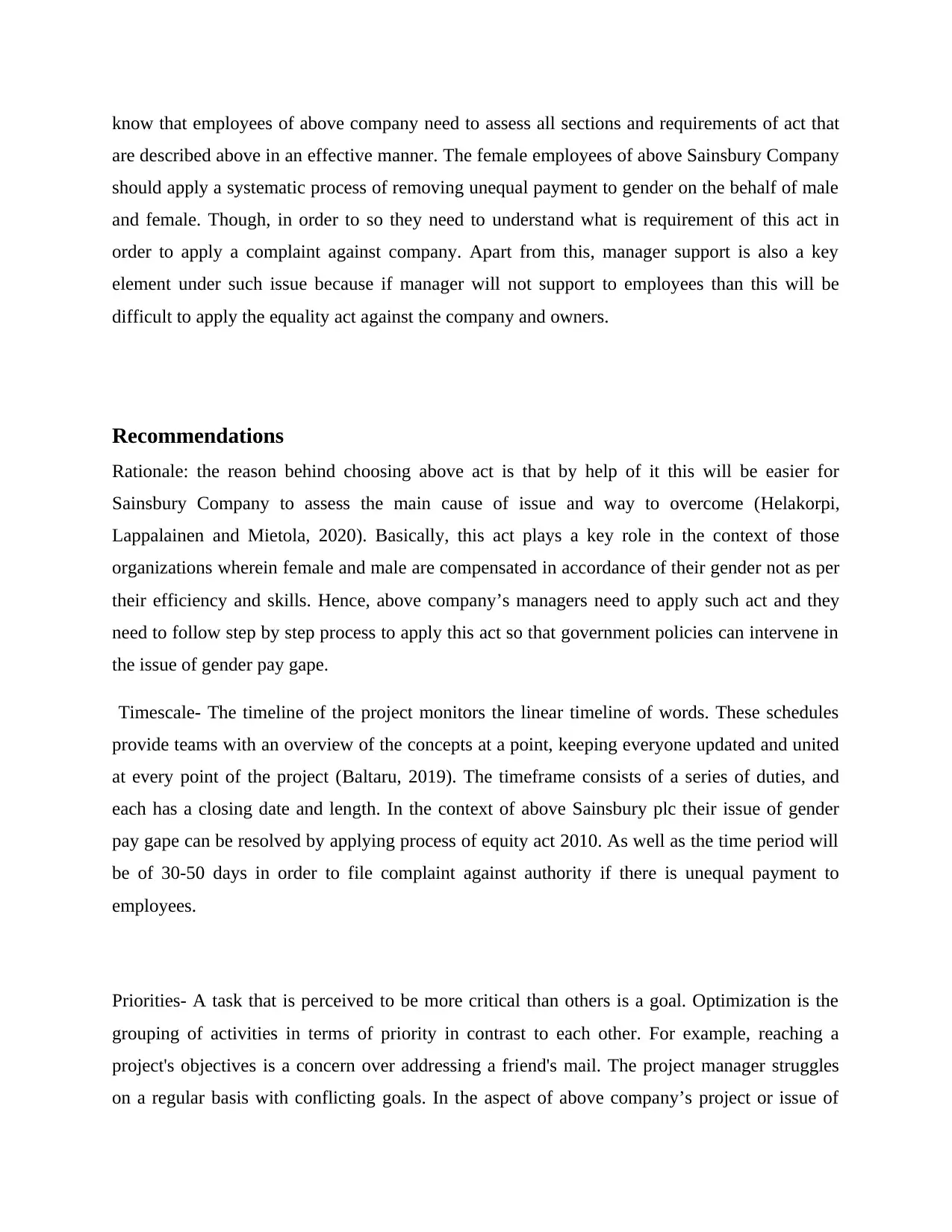
know that employees of above company need to assess all sections and requirements of act that
are described above in an effective manner. The female employees of above Sainsbury Company
should apply a systematic process of removing unequal payment to gender on the behalf of male
and female. Though, in order to so they need to understand what is requirement of this act in
order to apply a complaint against company. Apart from this, manager support is also a key
element under such issue because if manager will not support to employees than this will be
difficult to apply the equality act against the company and owners.
Recommendations
Rationale: the reason behind choosing above act is that by help of it this will be easier for
Sainsbury Company to assess the main cause of issue and way to overcome (Helakorpi,
Lappalainen and Mietola, 2020). Basically, this act plays a key role in the context of those
organizations wherein female and male are compensated in accordance of their gender not as per
their efficiency and skills. Hence, above company’s managers need to apply such act and they
need to follow step by step process to apply this act so that government policies can intervene in
the issue of gender pay gape.
Timescale- The timeline of the project monitors the linear timeline of words. These schedules
provide teams with an overview of the concepts at a point, keeping everyone updated and united
at every point of the project (Baltaru, 2019). The timeframe consists of a series of duties, and
each has a closing date and length. In the context of above Sainsbury plc their issue of gender
pay gape can be resolved by applying process of equity act 2010. As well as the time period will
be of 30-50 days in order to file complaint against authority if there is unequal payment to
employees.
Priorities- A task that is perceived to be more critical than others is a goal. Optimization is the
grouping of activities in terms of priority in contrast to each other. For example, reaching a
project's objectives is a concern over addressing a friend's mail. The project manager struggles
on a regular basis with conflicting goals. In the aspect of above company’s project or issue of
are described above in an effective manner. The female employees of above Sainsbury Company
should apply a systematic process of removing unequal payment to gender on the behalf of male
and female. Though, in order to so they need to understand what is requirement of this act in
order to apply a complaint against company. Apart from this, manager support is also a key
element under such issue because if manager will not support to employees than this will be
difficult to apply the equality act against the company and owners.
Recommendations
Rationale: the reason behind choosing above act is that by help of it this will be easier for
Sainsbury Company to assess the main cause of issue and way to overcome (Helakorpi,
Lappalainen and Mietola, 2020). Basically, this act plays a key role in the context of those
organizations wherein female and male are compensated in accordance of their gender not as per
their efficiency and skills. Hence, above company’s managers need to apply such act and they
need to follow step by step process to apply this act so that government policies can intervene in
the issue of gender pay gape.
Timescale- The timeline of the project monitors the linear timeline of words. These schedules
provide teams with an overview of the concepts at a point, keeping everyone updated and united
at every point of the project (Baltaru, 2019). The timeframe consists of a series of duties, and
each has a closing date and length. In the context of above Sainsbury plc their issue of gender
pay gape can be resolved by applying process of equity act 2010. As well as the time period will
be of 30-50 days in order to file complaint against authority if there is unequal payment to
employees.
Priorities- A task that is perceived to be more critical than others is a goal. Optimization is the
grouping of activities in terms of priority in contrast to each other. For example, reaching a
project's objectives is a concern over addressing a friend's mail. The project manager struggles
on a regular basis with conflicting goals. In the aspect of above company’s project or issue of
Paraphrase This Document
Need a fresh take? Get an instant paraphrase of this document with our AI Paraphraser
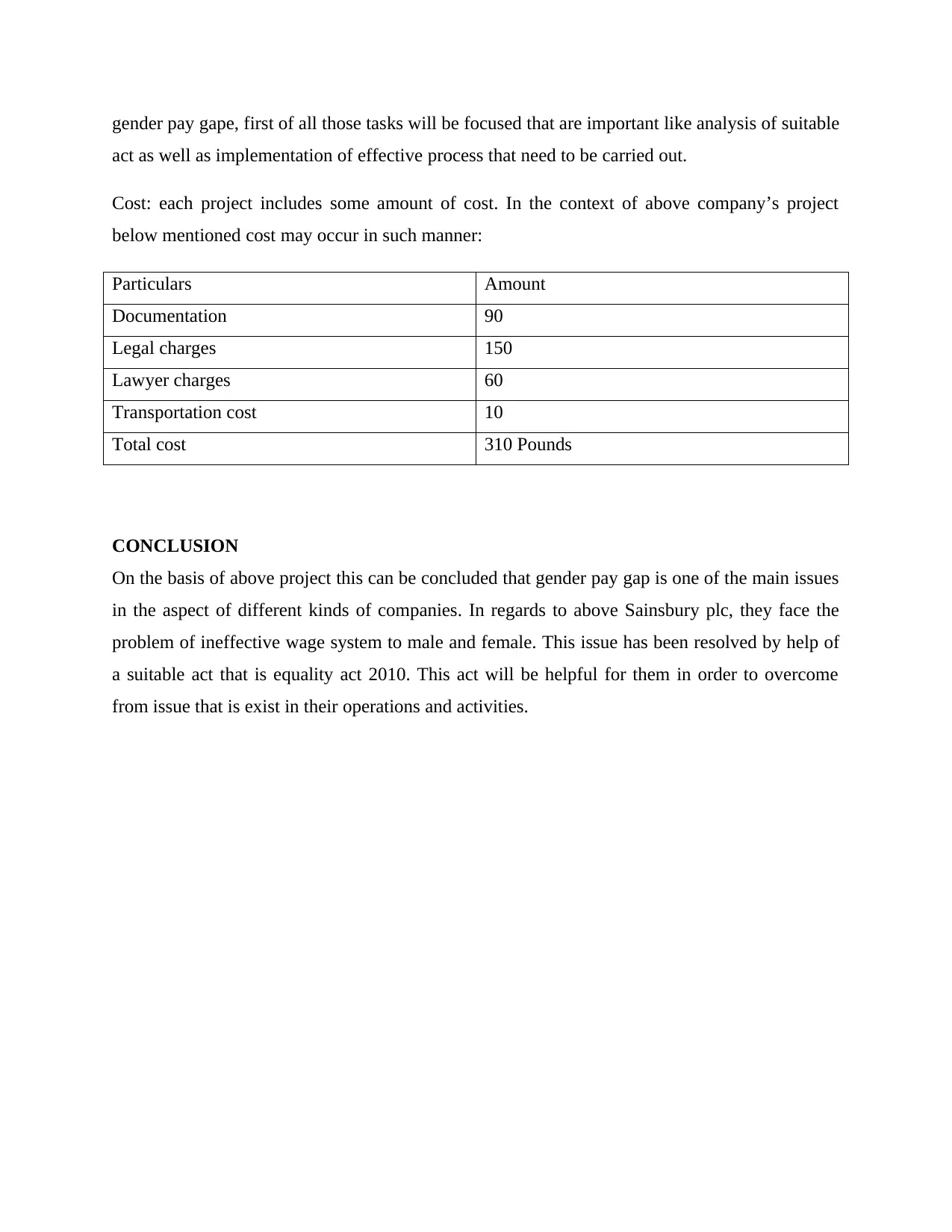
gender pay gape, first of all those tasks will be focused that are important like analysis of suitable
act as well as implementation of effective process that need to be carried out.
Cost: each project includes some amount of cost. In the context of above company’s project
below mentioned cost may occur in such manner:
Particulars Amount
Documentation 90
Legal charges 150
Lawyer charges 60
Transportation cost 10
Total cost 310 Pounds
CONCLUSION
On the basis of above project this can be concluded that gender pay gap is one of the main issues
in the aspect of different kinds of companies. In regards to above Sainsbury plc, they face the
problem of ineffective wage system to male and female. This issue has been resolved by help of
a suitable act that is equality act 2010. This act will be helpful for them in order to overcome
from issue that is exist in their operations and activities.
act as well as implementation of effective process that need to be carried out.
Cost: each project includes some amount of cost. In the context of above company’s project
below mentioned cost may occur in such manner:
Particulars Amount
Documentation 90
Legal charges 150
Lawyer charges 60
Transportation cost 10
Total cost 310 Pounds
CONCLUSION
On the basis of above project this can be concluded that gender pay gap is one of the main issues
in the aspect of different kinds of companies. In regards to above Sainsbury plc, they face the
problem of ineffective wage system to male and female. This issue has been resolved by help of
a suitable act that is equality act 2010. This act will be helpful for them in order to overcome
from issue that is exist in their operations and activities.
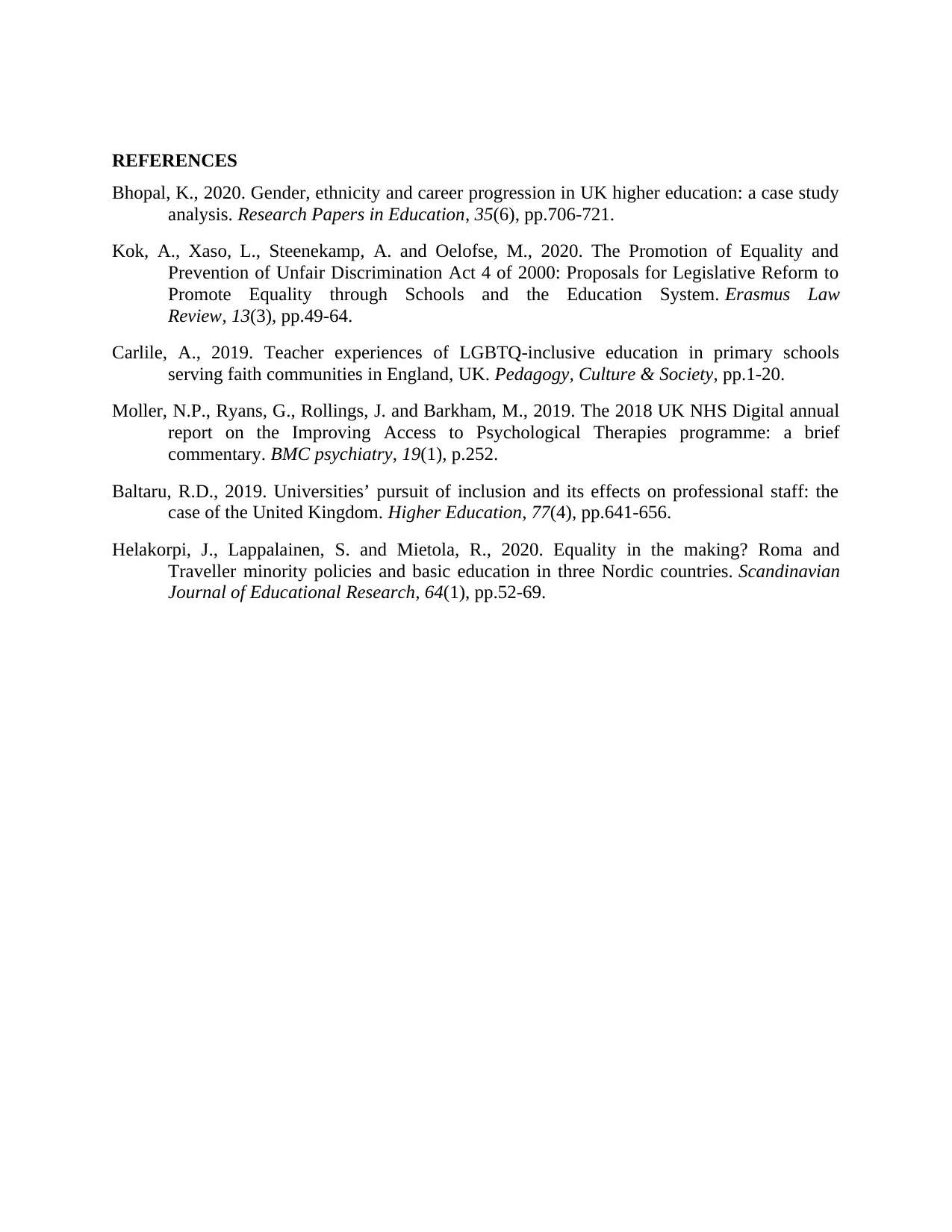
REFERENCES
Bhopal, K., 2020. Gender, ethnicity and career progression in UK higher education: a case study
analysis. Research Papers in Education, 35(6), pp.706-721.
Kok, A., Xaso, L., Steenekamp, A. and Oelofse, M., 2020. The Promotion of Equality and
Prevention of Unfair Discrimination Act 4 of 2000: Proposals for Legislative Reform to
Promote Equality through Schools and the Education System. Erasmus Law
Review, 13(3), pp.49-64.
Carlile, A., 2019. Teacher experiences of LGBTQ-inclusive education in primary schools
serving faith communities in England, UK. Pedagogy, Culture & Society, pp.1-20.
Moller, N.P., Ryans, G., Rollings, J. and Barkham, M., 2019. The 2018 UK NHS Digital annual
report on the Improving Access to Psychological Therapies programme: a brief
commentary. BMC psychiatry, 19(1), p.252.
Baltaru, R.D., 2019. Universities’ pursuit of inclusion and its effects on professional staff: the
case of the United Kingdom. Higher Education, 77(4), pp.641-656.
Helakorpi, J., Lappalainen, S. and Mietola, R., 2020. Equality in the making? Roma and
Traveller minority policies and basic education in three Nordic countries. Scandinavian
Journal of Educational Research, 64(1), pp.52-69.
Bhopal, K., 2020. Gender, ethnicity and career progression in UK higher education: a case study
analysis. Research Papers in Education, 35(6), pp.706-721.
Kok, A., Xaso, L., Steenekamp, A. and Oelofse, M., 2020. The Promotion of Equality and
Prevention of Unfair Discrimination Act 4 of 2000: Proposals for Legislative Reform to
Promote Equality through Schools and the Education System. Erasmus Law
Review, 13(3), pp.49-64.
Carlile, A., 2019. Teacher experiences of LGBTQ-inclusive education in primary schools
serving faith communities in England, UK. Pedagogy, Culture & Society, pp.1-20.
Moller, N.P., Ryans, G., Rollings, J. and Barkham, M., 2019. The 2018 UK NHS Digital annual
report on the Improving Access to Psychological Therapies programme: a brief
commentary. BMC psychiatry, 19(1), p.252.
Baltaru, R.D., 2019. Universities’ pursuit of inclusion and its effects on professional staff: the
case of the United Kingdom. Higher Education, 77(4), pp.641-656.
Helakorpi, J., Lappalainen, S. and Mietola, R., 2020. Equality in the making? Roma and
Traveller minority policies and basic education in three Nordic countries. Scandinavian
Journal of Educational Research, 64(1), pp.52-69.
⊘ This is a preview!⊘
Do you want full access?
Subscribe today to unlock all pages.

Trusted by 1+ million students worldwide
1 out of 9
Related Documents
Your All-in-One AI-Powered Toolkit for Academic Success.
+13062052269
info@desklib.com
Available 24*7 on WhatsApp / Email
![[object Object]](/_next/static/media/star-bottom.7253800d.svg)
Unlock your academic potential
Copyright © 2020–2025 A2Z Services. All Rights Reserved. Developed and managed by ZUCOL.




